Innoxa
Continued onto: Innoxa (1930-1945)
In the western suburbs of Paris, in Garches, sits a complex of buildings that once housed a model pharmaceutical factory. Built in a parkland setting, the factory is surrounded by a village of some twenty residences once used to house the families of factory employees. The man behind the creation of this model workers’ city was its managing director, Dr. François Debat, also known as the origination of Innoxa.
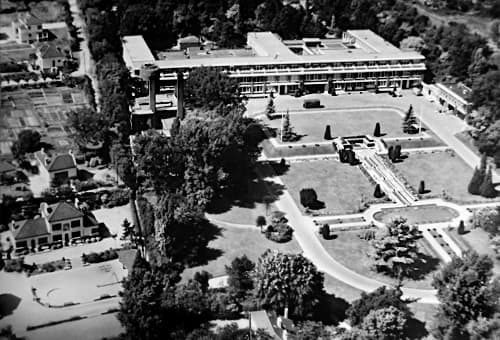
Above: 1970 A partial aerial view of the Laboratoires du Dr. François Debat at 153 Rue de Buzenval, Garches, showing the laboratory, some employee housing and a vegetable garden. Development started in the late 1920s but was not fully completed until 1956.
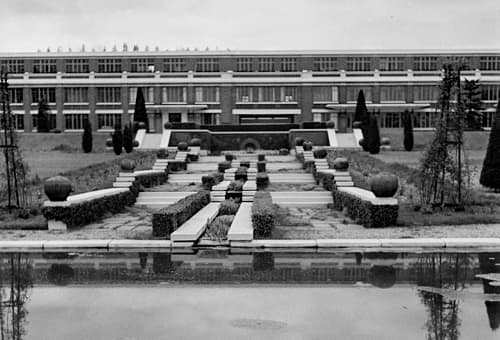
Above: 1941 The laboratories of Dr. François Debat after the building was remodelled in 1933. Architect: Jean Barot [1900-1967].
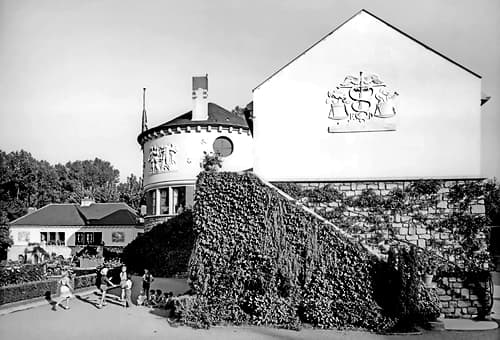
Above: c.1950 The large communal hall (centre) and a residential building (left) used to house the families of factory employees. Architect: René Crevel [1892-1971]. Crevel also designed the frescos that adorned the building.
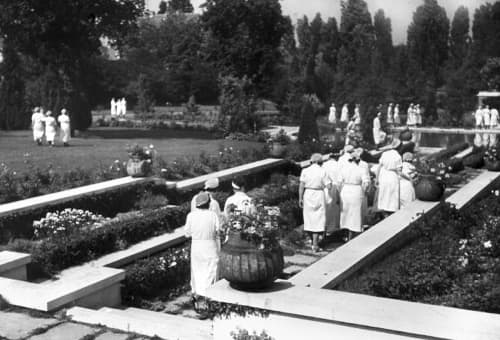
Above: 1939 Factory workers and residents had access to the well-maintained parklands, flower gardens and vegetable garden.
François Debat
Biographers of Debat’s early life state that he was born in Angoulême into a family of farmers but started school in Bordeaux before completing his secondary education at the Lycée Carnot in Paris in 1900. Deciding to go into pharmacy, he took up an internship at the Laboratoires de l’Uraseptine Rogier, Paris before moving to the Hôpital Sainte-Antoine, Paris in 1906. After receiving his Doctorate in Pharmacy in 1908 he stayed at Sainte-Antoine working in the laboratory of the dermatologist Dr. Lucien Jacquet [1860-1914], rising to become head of the laboratory in 1912 (François Debat de l’industrie à l’Académie des Beaux-Arts Angoulême, n.d.).
Debat became a Doctor of Medicine in 1914, after being encouraged by Jacquet. By then, the First World War had begun and Debat was mobilised, serving in the French army, first as a pharmacist and then as a doctor. During the war he treated wounds and other dermatological afflictions writing up much of what he learnt in the ‘Larousse Médical Illustré de Guerre’ published in 1917, a book detailing the medical practices used to treat soldiers during the First World War. Debat is listed in Larousse as “Dr. F. Debat, aide-major, chef du service dermatologie de la 8e région, assistant de dermatologie à l’hôpital Sainte-Antoine.”
By 1914, Debat was also manufacturing Innotyol, a skin treatment for eczema, ulcers, burns and other skin conditions, at the Laboratoire Innoxa, 21 Rue du Faubourg, Montmartre, Paris. After the First World War Debat continued to make Innotyol, then at 35 Rue des Petits-Champs.
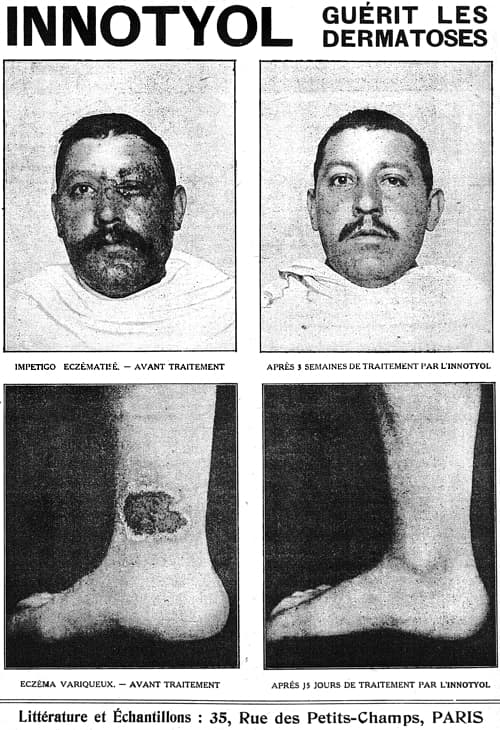
Above: 1920 Innotyol.
Innoxa products
Predating Innotyol were three other Innoxa products – Lait Innoxa, Poudre Innoxa, and Cold Cream Innoxa. The earliest records I have for them date from 1911 but, as they were then available in France, England, Russia, Argentina, and Cuba, their origins may have been a year or two earlier than this.
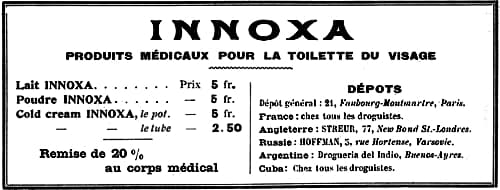
Above: 1911 Lait Innoxa, Cold-Cream Innoxa, and Poudre Innoxa. ‘Products méicaux pour la toilette du visage’.
Initially, advertising was directed at the medical profession with Debat promoting the three Innoxa lines as ‘produits médicaux’ (medical products). This, the inclusion of Innotyol as an Innoxa product, and later Innoxa advertisements that included some medical claims, suggests that Debat may have originally intended to produce a range of pharmaceutical products under the Innoxa label but later changed his mind.
Lait Innoxa (Innoxa Milk) was a lanolin, cocoa-butter, rose-water emulsion used as a non-irritating replacement for soap. Cold Cream Innoxa also contained lanolin to help soften the skin, prevent and heal sores, cracks and wrinkles. It was also used as a base for Poudre Innoxa, formulated with rice starch, talc and zinc-oxide to mask redness, prevent tanning and give the skin a velvety appearance.
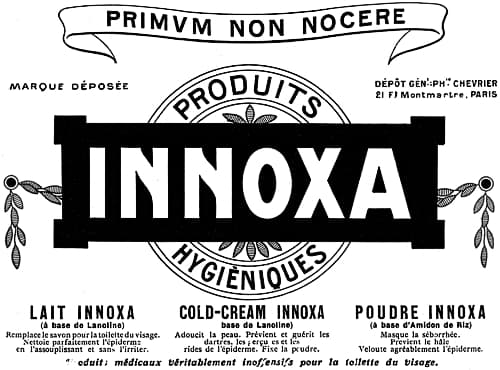
Above: 1913 Lait Innoxa, Cold-Cream Innoxa, and Poudre Innoxa. The dictum primum non nocere, first and foremost preparations must be innocuous, is the reason behind the name Innoxa.
By 1918, Laboratoire Innoxa had opened an outlet at 22 Avenue de l’Opera, Paris and Mousse Innoxa, Savon Innoxa, and Pulvérisation Astringente Innoxa had been added to the range. Mousse Innoxa was a light, frothy day cream possibly a ‘snow’ or ‘foam’ type of vanishing cream; Savon Innoxa, a soap; and Pulvérisation Astringente Innoxa, an astringent to be used with an atomiser, known as a pulvériser in France.
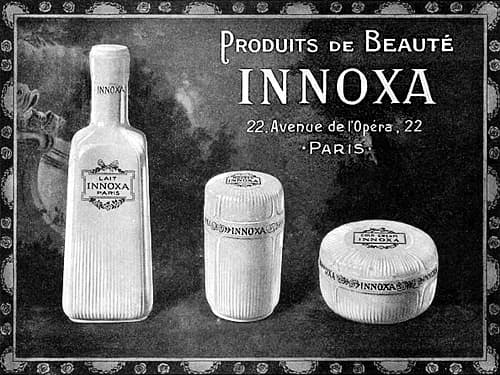
Above: 1921 Lait Innoxa, Mousse Innoxa, and Cold Cream Innoxa.
Also see: Vanishing Creams and Vaporisers (Steamers & Atomisers)
Other products added the Innoxa range by 1920 included an Eau de Cologne; an anti-dandruff treatment to help prevent hair loss; a dentrifice; and Crayon Anti-Moustique used against mosquito bites. Some of these would now be regarded as pharmaceuticals not cosmetics.
In 1921, Debat founded the Laboratoire Inotyol giving Innotyol a name change and separating it from other Innoxa products. Laboratoire Inotyol was still based at the 35 Rue des Petits-Champs address for Innoxa but it relocated to 12 Rue Sainte-Anne in 1924.

Above: 1922 Inotyol now available as a cream, powder and soap.
By 1925, Innoxa had added Crème Innoxine and Poudre Innoxine, both cosmetics designed for individuals with dry skin, with Innoxine probably being a form of lanolin. The addition of these new cosmetics gave Innoxa treatment regimes for Normal, Oily and Dry skin types:
1. Normal skin
Morning: Wash with lukewarm water then wipe the face with cotton or linen impregnated with Lait Innoxa.
Remove the remaining Lait Innoxa then apply Mousee Innoxa before powdering with Poudre Innoxa.
Evening: Cleanse the skin of dirt and dust with Lait Innoxa then apply Cold Cream Innoxa to nourish the skin.
2. Oily skin
Morning: Wash with lukewarm water to which a teaspoon of borate of soda per litre has been added then wipe the face with cotton or linen impregnated with Lait Innoxa.
Apply Cold Cream Innoxa before powdering with Poudre Innoxa.
During the day: Renew the powder if the face shines.
Evening: Cleanse the skin of dirt and dust with Lait Innoxa then apply Cold Cream Innoxa to nourish the skin.
3. Dry skin
Morning: Wash with lukewarm water then wipe the face with cotton or linen impregnated with Lait Innoxa.
Remove the remaining Lait Innoxa then apply Mousee Innoxa before powdering with Poudre Innoxine.
Evening: Cleanse the skin of dirt and dust with Lait Innoxa then apply Crème Innoxine.
Laboratoires Innoxa
In 1920, Debat put Innoxa on a firm footing by founding the Société des Laboratoires Innoxa, capital of 500,000 Fr. – increased to 1 million Fr. in 1922. Shares were divided between Debat and two siblings of Dr. Lucien Jacquet – Auguste Jacquet [1868-1962] and possibly Louis Jacquet [1864-1924] – a recognition of the funds the Jacquet family had invested in the business. The company offices were listed at 35 Rue des Petits-Champs but moved to 12 Rue Sainte-Anne in 1924, along with Inotyol, while maintaining the shop at 22 Avenue de l’Opera.
In 1925, Debat reorganised his business interests to reflect his growing interest in pharmaceuticals and to demarcate them from Innoxa cosmetics. A new company, Innoxa Société Anonyme (S.A.), capital 2.5 million Fr., was created to handle the Innoxa perfumes and cosmetics and it continued to maintain the shop at 22 Avenue de l’Opera. The Société des Laboratoires Innoxa became the Société des Laboratoires du Docteur Debat and had its capital increased to 5 million Fr. Both companies were listed at 12 Rue Sainte-Anne but moved to 60 Rue de Prony in 1929, the year that Debat began building the factory at Garches.
In 1925, the year that Innoxa S.A was created, Paris hosted the ‘Exposition Internationale des Arts Décoratifs et Industriels Modernes’, generally recognised as the beginnings of the ‘style moderne’ or ‘art deco’. Innoxa placed a ‘deco’ inspired image in the exhibition catalogue that the company would use for a number of years. It is perhaps a reflection of Debat’s strong interest in the arts.
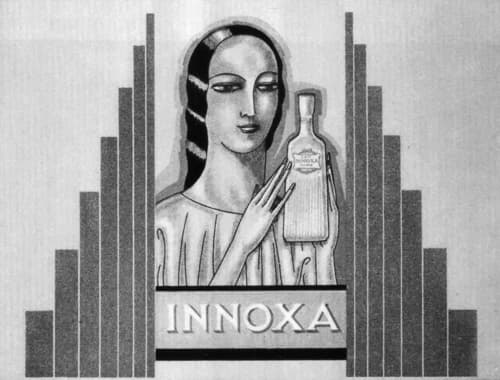
1925 Innoxa advertisement placed in the ‘Exposition Internationale des Arts Décoratifs et Industriels Modernes’ catalogue.
By this time, Innoxa was selling its cosmetics throughout much of the world with branches or agencies in Algiers, London, Turin, Barcelona, Brussels, Athens, Geneva, Copenhagen, Stockholm, Tehran, Casablanca, Cairo, Buenos Aires, Antofagasta, and Havana.
United Kingdom
Innoxa was available in England before the First World War but it was not until the 1920s that its presence there was substantial. An article on the Innoxa company in Britain, published in ‘Soaps, Perfumery & Cosmetics’ (SPC) in 1962 suggests that this began in 1921 when Albert Alberman [1892-1971] began importing Innoxa into the United Kingdom. It also suggests that Innoxa (England) was formed in 1932/3 along with the establishment of a factory to manufacture Innoxa products. However, this may not be the full story.
Alberman was born in Lithuania and, after coming to England, was apprenticed as a pharmacist. In 1923, he was working as the manager for the pharmacist Theodore Kempston [c.1865-1923]. Together with Kempston and his Kempston’s wife, he formed the French Drug Supply Co. Ltd. in March, 1923, capital £300. The business seems to have been primarily concerned with the importation of D’Arlay toilet preparations.
When Kempston died in April, 1923, Alberman bought the business, then operating at 17 Southhampton Street, London. It had moved to 5 Bennett Street by 1926 by which time it was importing Innoxa products from France. However, prior to this, from 1924 at least, Innoxa had an outlet at 15 Dover Street, Piccadilly, London.
Innoxa Preparations
The spring sunshine has an unpleasant knack of revealing the blemishes of our skin, and to camouflage the same is the greatest mistake. All and sundry will therefore be pleased to learn that the Innoxa preparations may now be obtained at 15, Dover Street, W. They are made from the prescriptions of an eminent French skin specialist, and they give to the skin a healthy and youthful appearance.(Innoxa advertisement, 1925)
Unfortunately, I have been unable to determine the identity of the importer at that address and whether they had connections to Alberman. This means that Alberman may have been involved and importing Innoxa into England from 1921 as the SPC article suggests.
The origins of Innoxa (England) Ltd. are also muddied. In 1927, Alberman placed an advertisement for Innoxa (England) Ltd. in ‘Chemist & Druggist’ giving 5 Bennett Street as the company address which is earlier than the date in the SPC article. Unfortunately, I have been unable to find any record of its actual creation.
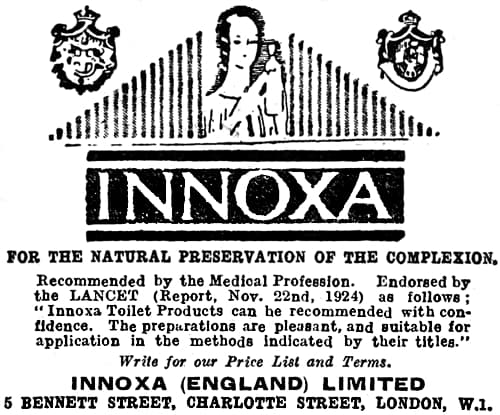
1927 Innoxa (England) Ltd.
A company that does have an establishment record is Beauté Ltd., founded in 1928 by Alberman with a salon, showrooms and offices at 38 Old Bond Street, London. Beauté Ltd. was the British outlet for Innoxa through most of the 1920s but, from 1929, Alberman dropped mentioning it and from then on only made references to Innoxa.
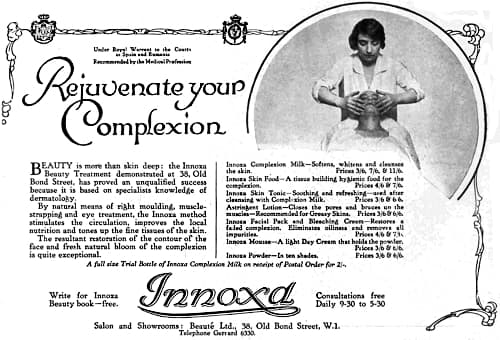
1928 Salon treatments at Beauté Ltd., 38 Old Bond Street, London.
Skin-care
Innoxa skin-care preparations available in Britain by 1930 included Innoxa Complexion Milk, Innoxa Mousse Day Cream, Innoxa Skin Balm, Innoxa Skin Tonic, Innoxa Skin Food, Innoxa Astringent Lotion, Innoxa Antishine Cream and Innoxa Facial Pack. I have been unable to find French equivalents for some of these cosmetics but as all the products were imported I assume they existed in France in some form. Innoxa Skin Balm and Innoxa Skin Food included Inoxine (Innoxine) which suggests they contained lanolin.
Innoxa Skin Balm: “Inoxine formula. Specially recommended for dry and delicate skins.”
Innoxa Skin Food: “Inoxine formula. Contains valuable skin rejuvenating and tissue building ingredients prepared under medical supervision, a genuine hygienic food and tonic for the complexion.”
Innoxa Facial Pack: “Owing to its bleaching properties, this Pack stimulates blood circulation and restores youthful colour and bloom to sallow and faded complexions.”
See also: Skin Foods
North America
Innoxa was available in Canada from 1925 at least, imported directly from France by the Union Commerciale France-Canada through their agent J. I. Eddé, based in the New Birks Building, Montreal.
By 1927, Innoxa was also established in the United States when Innoxa Laboratories Inc., importers of Innoxa preparations, opened executive offices at 23 Beaver Street and showrooms at 303 Fifth Avenue, New York. Supplies appear to have come from Innoxa (England).
The creation of the New York company seems to have triggered a trip by Debat to the United States. He arrived there with his wife Marie on the S.S. Paris in October 1928 and subsequently wrote up his impressions of New York in a book ‘New York: Images Mouvantes’ in 1929.
Art et Médecine
In 1929, Debat also began publishing ‘La Review du Médecin’ which became ‘Art et Médecine’ in 1930, published through to 1939. The magazine combined articles on medicine with artistic contributions from notable avant-garde photographers and writers of the 1930s. It was supplied free of charge to doctors to put in their waiting rooms and was funded by advertising for Debat products, including Innoxa.
Timeline
| n.d. | New Products: Lait Innoxa; Poudre Innoxa; and Cold Cream Innoxa (France). |
| 1920 | Société des Laboratoires Innoxa founded in Paris. New Products: Mousse Innoxa. |
| 1925 | Innoxa S.A. founded at 35 Rue des Petits-Champs. Société des Laboratoires Innoxa becomes the Société des Laboratoires du Docteur Debat. |
| 1927 | Innoxa Laboratories, Inc. opens showrooms and offices in New York. |
| 1928 | Beauté Ltd. founded in London. London salon and showroom opened at 38 Old Bond Street. |
| 1929 | French headquarters moved to 60 Rue de Prony. |
Continued onto: Innoxa (1930-1945)
First Posted: 30th May 2021
Sources
The American Perfumer & Essential Oil Review. (1906-1955). New York: Robbins Perfumer Co. [etc.].
The chemist and druggist. (1859-) London: Morgan Brothers.
François Debat de l’industrie à l’Académie des Beaux-Arts Angoulême. [n.d.] Retrieved April 30, 2021, from https://www.aaiiphp.org/uploaded/debat.pdf
Galtier-Boissière, Dr. (1917). Larousse Médical Illustré de Guerre. Paris: Librairie Larousse.
The house of Innoxa: Past, present and prospects for the future. (1962). Soaps, perfumery & cosmetics. August, 716-720.
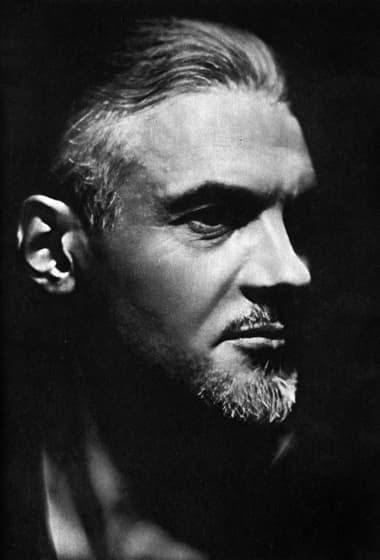
c.1929 Dr. François Séraphique Debat [1882-1956].
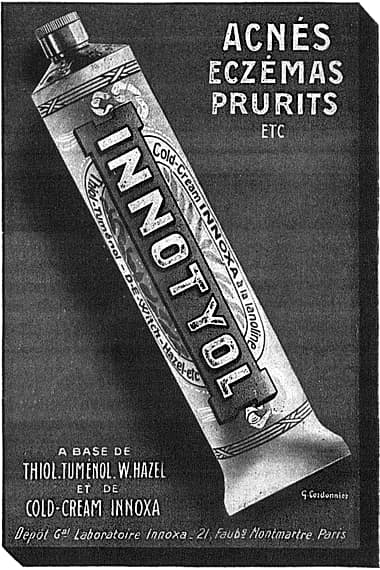
1914 Innotyol made with witch hazel extract, ichthammol, Peru balsam, camphor, sodium borate and zinc oxide.

1920 Innoxa products (Spain)
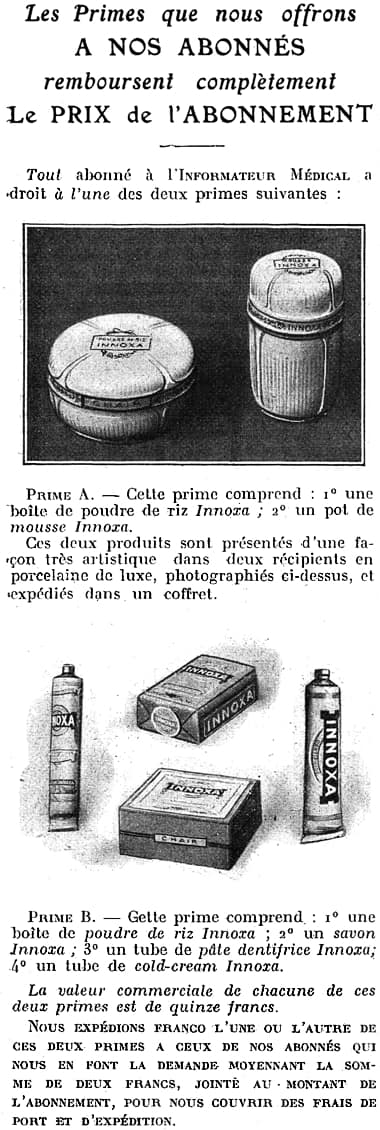
1922 Top: Poudre de Riz Innoxa and Mousse Innoxa. Bottom: Cold Cream Innoxa, Savon Innoxa, Poudre de Riz Innoxa, and Pâte Detrifice Innoxa.
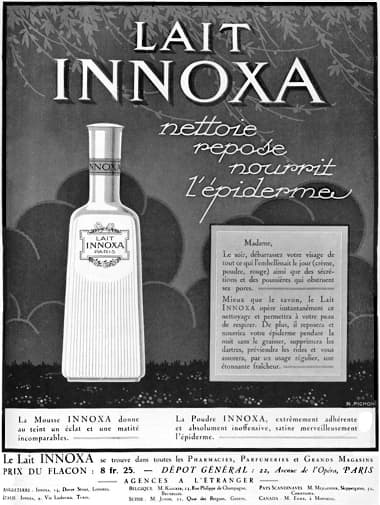
1924 Lait Innoxa. Listed agencies are: London, Turin, Brussels, Geneva, Copenhagen, and Montreal.

1925 Laboratoires Innoxa (Canada).
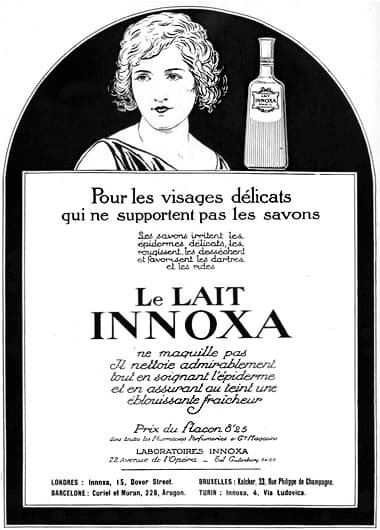
1926 Lait Innoxa. Listed agencies are: London, Barcelona, Brussels and Turin.
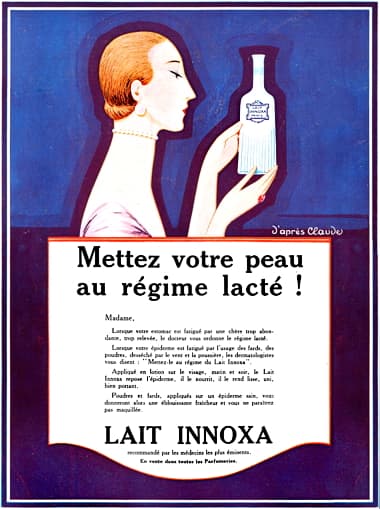
1926 Lait Innoxa.
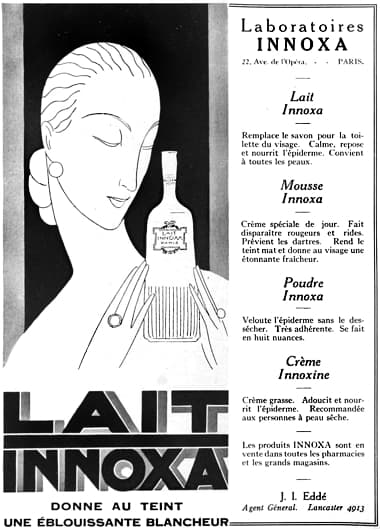
1926 Lait Innoxa (Canada).
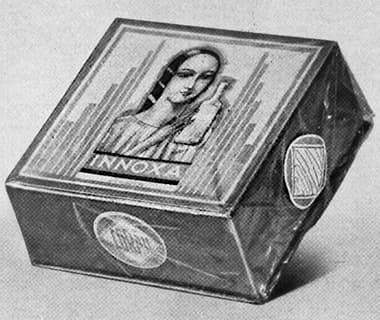
1927 Poudre Innoxa.

1927 Lait Innoxa (USA).
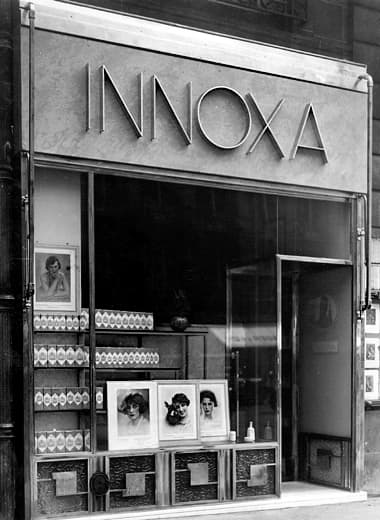
1928 Innoxa Salon at 22 Avenue de l’Opera, Paris. There is a sample of Lait Innoxa, Mouse Innoxa and Cold Cream Innoxa in the bottom right of the window. The rows of cartons are most likely Lait Innoxa, the line’s biggest seller. The pictures in the window appear to be product endorsements.
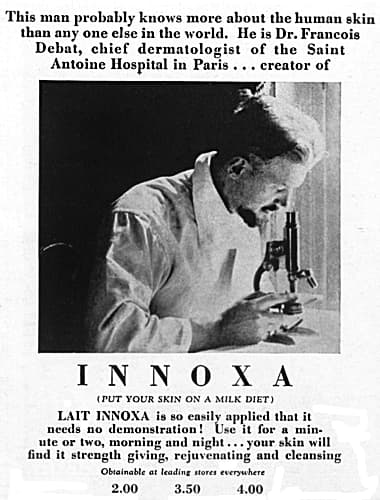
1928 Lait Innoxa (USA).
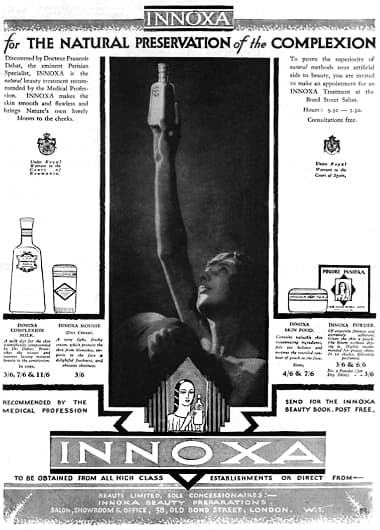
1928 Innoxa Complexion Milk, Mousse, Skin Food, and Powder (UK).
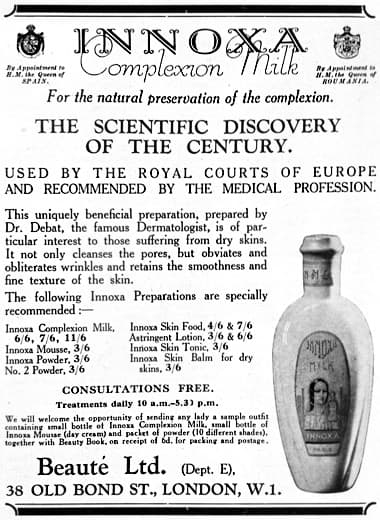
1928 Beauté Ltd. (UK).
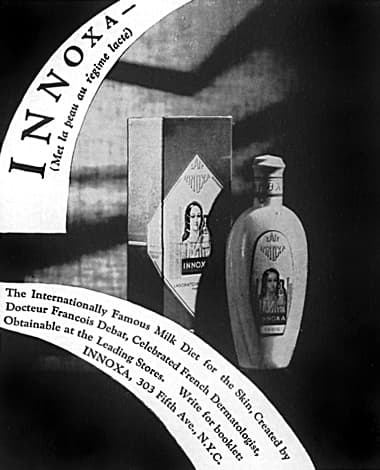
1928 Lait Innoxa (USA). The bottle is the same as the one used in Britain. The older tall bottle was still being used in France well into the 1930s.
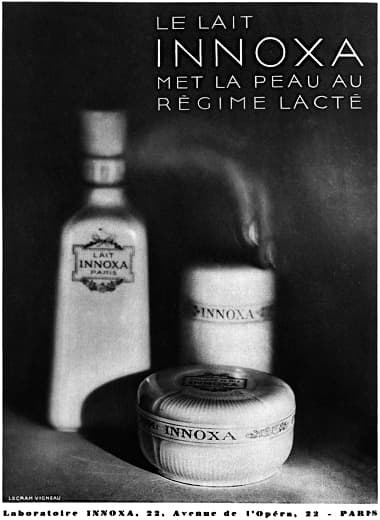
1929 Lait Innoxa, Mousse Innoxa and Cold Cream Innoxa.
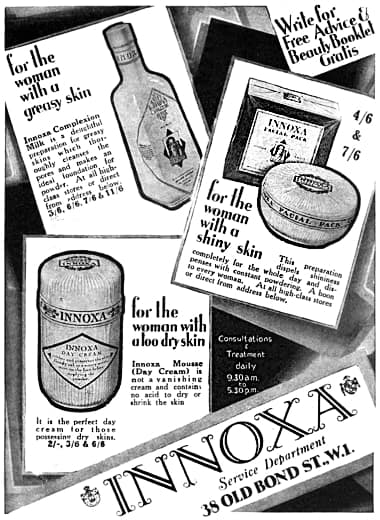
1929 Innoxa Complexion Milk, Mousse (Day Cream), and Facial Pack (UK).
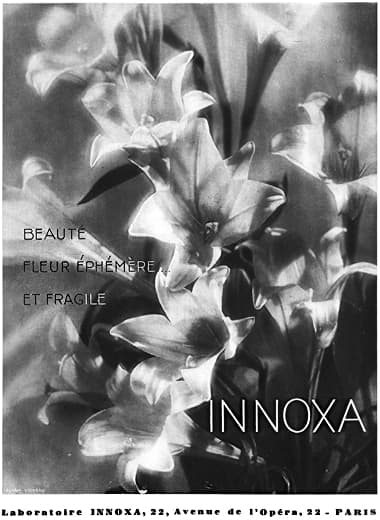
1929 Innoxa.
